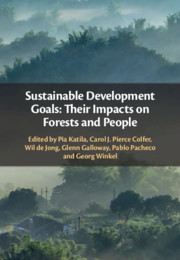The world’s leaders agreed on the Sustainable Development Agenda, or Agenda 2030, in September 2015, and it officially came into force on 1 January 2016. The agenda is embodied in 17 Sustainable Development Goals (SDGs) and 169 associated targets to be achieved by 2030. Agenda 2030 applies to all countries and is now the major framework for guiding development policies and efforts across local to global scales. It calls for transformative changes to increase human well-being and prosperity while addressing environmental protection and climate change.
Human survival and well-being ultimately rest on the natural resources of the planet. Forests cover about a third of the world’s land area and provide a wide range of ecosystem services that are crucial for human well-being and sustainable development worldwide. How forests and trees are included in Agenda 2030 and how the efforts undertaken by different sectors to advance towards the 17 SDGs will impact forests, forest ecosystem services, forest-related livelihoods and human well-being are thus important questions. Little attention, however, has yet focused on these issues, or on how the potential impacts, in turn, will support or undermine the contributions of forests to climate and sustainable development. Understanding the potential impacts of the SDGs on forests and forest-related livelihoods and development as well as the related trade-offs and synergies is crucial for efforts undertaken to reach these goals. It is especially important for reducing potential negative impacts and to leverage opportunities to create synergies that will ultimately determine whether comprehensive progress towards the SDGs will be accomplished.
Realisation of the lack of discussion on the potential and likely impacts of the SDGs on forests and forest-related livelihoods and the related synergies and trade-offs motivated the International Union of Forest Research Organizations (IUFRO) Special Project World Forests, Society and Environment (WFSE) to develop this book. It provides a systematic scientific assessment of potential and anticipated impacts of efforts to achieve the SDGs on forests, related socio-economic systems and forest-related development. It discusses the conditions that influence how SDGs are implemented and prioritised, and how these conditions and SDG implementation influence these impacts. Furthermore, it considers the important interconnections and linkages among the SDGs and the potential or anticipated trade-offs and synergies among the SDGs from the perspective of forests and related socio-economic systems, shedding light on how SDG implementation may transform existing forest-related development scenarios and affect the roles of forests in sustainable development in the future.
WFSE is a wide, open, independent network of experts and scientists coordinated by the Natural Resources Institute Finland (Luke). WFSE supports sustainable natural resource management, sustainable development and livelihoods, and related policy processes. It focuses on topics in the forest, society and environment interface that are recognised by the scientific community as important and having significant policy implications, but which appear not to be receiving adequate attention from the policy community. It addresses these topics in a holistic, interdisciplinary and collaborative manner, producing science-based, future-oriented, policy-relevant information.
The development of this book started by identifying and inviting a core group of lead authors to address the above-mentioned questions from the point of view of each of the SDGs. The lead authors were further tasked to form an international team of authors to collaborate in writing the SDG chapters.
In the course of the development of this book we organised two large workshops that brought together the lead authors of the SDG chapters and the editors of the book. The first workshop was organised in collaboration with the Food and Agriculture Organization of the United Nations (FAO) in Rome, Italy, in March 2018. The event brought together the lead authors and editors of the volume and colleagues from the FAO to discuss forest and SDGs interactions, especially the potential and likely impacts of the SDGs and their implementation on forests and related socio-economic systems.
The second workshop for developing this publication was organised in conjunction with the European Forest Institute’s (EFI) Annual Conference and Scientific Seminar in Sardinia, Italy, in September 2018. This workshop concentrated on the main findings from the SDG chapters and the contextual conditions that influence how the SDGs are taken up and prioritised.
Furthermore, the editors of this book convened at the University of Florida, Gainesville, USA, in December 2018 to develop and discuss the findings and conclusions of the book.

